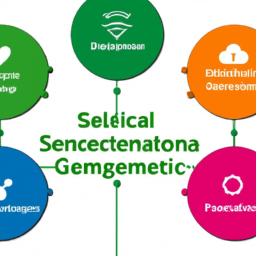Do you want to conquer the Six Sigma Green Belt exam? Well, look no further! In this article, we’ve got 9 must-know tips that will help you pass with flying colors.
It’s time to dive into the world of Six Sigma methodology and familiarize yourself with the DMAIC process. Master statistical analysis tools, interpret process capability metrics, and practice root cause analysis techniques.
Enhance your project management, communication, and presentation skills. Don’t forget to utilize lean principles and take mock exams to ace the big day.
Let’s get started!
Key Takeaways
- Familiarize yourself with the DMAIC framework for identifying and improving root causes of problems.
- Learn and practice statistical analysis tools and process capability metrics to evaluate process performance.
- Use root cause analysis techniques like the 5 Whys or Fishbone diagram to identify underlying issues.
- Develop strong project management and communication/presentation skills to effectively implement Six Sigma methodologies.
Understand the Six Sigma Methodology
To pass the Six Sigma Green Belt exam, it’s important that you have a strong understanding of the Six Sigma methodology. Six Sigma is a systematic approach to quality improvement, focusing on reducing defects and variations in processes.
Understanding the principles and tools of Six Sigma implementation is essential for success in the exam. You need to familiarize yourself with the DMAIC (Define, Measure, Analyze, Improve, Control) framework, as it forms the foundation of Six Sigma projects.
Additionally, understanding quality improvement strategies, such as statistical analysis, process mapping, and root cause analysis, will help you identify and solve problems effectively. By mastering the Six Sigma methodology and its implementation techniques, you will be well-prepared to tackle the green belt exam confidently.
Familiarize Yourself With DMAIC
Get familiar with DMAIC—it’s essential for the Six Sigma Green Belt exam. DMAIC stands for Define, Measure, Analyze, Improve, and Control. This is the core process of the Six Sigma methodology. Understanding the DMAIC process is crucial for achieving process improvement and reducing defects.
The importance of DMAIC in Six Sigma lies in its systematic approach to problem-solving and data-driven decision making. Each step in the DMAIC process has a specific purpose and helps in identifying, analyzing, and improving the root causes of problems.
By following the DMAIC process, you can effectively define project goals, measure process performance, analyze data to identify improvement opportunities, implement solutions, and establish control mechanisms to sustain the improvements.
Familiarizing yourself with DMAIC will not only help you pass the Six Sigma Green Belt exam but also equip you with the necessary skills to drive continuous improvement in any organization.
Master Statistical Analysis Tools
By mastering statistical analysis tools, you’ll be able to effectively analyze data and make informed decisions in your process improvement efforts. Here are some tips to help you in mastering statistical software and understanding statistical terms:
-
Familiarize yourself with the key statistical software programs such as Minitab, Excel, and SPSS.
-
Learn the basic statistical terms such as mean, median, mode, standard deviation, and correlation coefficient.
-
Practice using these tools and terms on real-life data sets to gain hands-on experience and improve your understanding.
-
Take advantage of online tutorials, courses, and practice quizzes to enhance your knowledge and skills.
-
Stay updated with the latest advancements in statistical analysis tools to ensure you are using the most efficient and effective methods.
-
Network with other professionals in the field to learn from their experiences and gain additional insights.
Learn to Interpret Process Capability Metrics
When it comes to evaluating the performance of a process, understanding key process capability metrics is essential. These metrics provide valuable insights into how well a process is meeting specifications and whether it is capable of meeting customer requirements.
In this discussion, you will learn about the important process capability metrics to consider and practical interpretation techniques that will help you make informed decisions about process improvement.
Key Process Capability Metrics
Understanding the key process capability metrics is crucial for passing the six sigma green belt exam. These metrics provide valuable insights into the performance and potential of a process. When interpreting process metrics, there are three key points to keep in mind:
-
Mean and Standard Deviation: These metrics help you understand the central tendency and variability of a process. The mean represents the average value, while the standard deviation indicates the dispersion of data points around the mean.
-
Process Capability Index (Cpk): Cpk measures how well a process meets customer specifications. It assesses the ability of a process to produce within the desired tolerance limits, taking into account both the mean and standard deviation.
-
Process Performance Index (Ppk): Ppk is similar to Cpk but considers the actual performance of a process, based on the natural variation. It takes into account the overall distribution of data points and assesses the process’s ability to meet customer requirements.
Practical Interpretation Techniques
Now that you have a solid understanding of key process capability metrics, let’s delve into practical interpretation techniques.
These techniques are crucial for applying your knowledge in real-world scenarios and will be tested in the six sigma green belt exam.
To excel in this area, it’s essential to grasp the practical application of process capability metrics. By analyzing case studies, you can gain insights into how these metrics are used to evaluate and improve processes.
Case studies provide a practical context that allows you to see how different industries and organizations apply these techniques to identify areas of improvement and drive operational excellence.
By studying and analyzing case studies, you’ll develop the skills needed to interpret process capability metrics effectively. This will enable you to make informed decisions and take actions that lead to process improvement and, ultimately, business success.
Practice Root Cause Analysis Techniques
In this discussion, you’ll learn how to identify underlying issues, develop an effective problem-solving approach, and apply data-driven decision-making.
Identifying the underlying issues is crucial in solving any problem. It allows you to address the root cause rather than just treating the symptoms.
Having an effective problem-solving approach is essential. It enables you to systematically analyze the problem, brainstorm solutions, and implement the best course of action.
Additionally, applying data-driven decision-making ensures that your solutions are based on objective evidence. This leads to more accurate and successful outcomes.
Identifying Underlying Issues
To identify underlying issues, you’ll need to analyze the data and look for patterns. Understanding root causes and applying problem-solving techniques are crucial in this process. Here are some tips to help you in identifying underlying issues:
-
Collect and analyze relevant data: Gather all the necessary data related to the problem at hand. This may include customer feedback, process data, and performance metrics.
-
Look for common trends: Examine the data for any recurring patterns or trends. Identify any similarities or differences that may be contributing to the problem.
-
Conduct root cause analysis: Use tools such as the 5 Whys or Fishbone diagram to dig deeper into the causes behind the identified patterns.
By following these steps, you’ll be able to uncover the true root causes of the problem and develop an effective problem-solving approach.
Now, let’s explore the next section about the ‘effective problem-solving approach’.
Effective Problem-Solving Approach
Are you ready to dive into the effective problem-solving approach and learn how to tackle issues head-on?
When it comes to problem-solving, having the right techniques and strategies in place is crucial. Being able to identify the root cause of a problem and develop effective solutions is a skill that can greatly benefit you in various aspects of your life.
By utilizing problem-solving techniques and critical thinking strategies, you can approach problems with a clear and logical mindset. This includes breaking down the problem into smaller components, analyzing the data, brainstorming possible solutions, and evaluating the pros and cons of each option.
By employing these techniques, you can develop a systematic approach to problem-solving that will help you overcome challenges and achieve your desired outcomes.
Now, let’s explore how applying data-driven decision-making can further enhance your problem-solving abilities.
Applying Data-Driven Decision-Making
Applying data-driven decision-making can greatly enhance your problem-solving abilities by providing you with valuable insights and evidence to inform your choices. By utilizing data to drive your decision-making process, you can ensure that your decisions are based on facts and analysis rather than assumptions or personal biases.
Here are three key benefits of data-driven decision-making:
-
Improved accuracy: By using data to inform your decisions, you can avoid making decisions based on incomplete or inaccurate information. This leads to more accurate and reliable decision-making.
-
Better insights: Data-driven decision-making allows you to uncover patterns, trends, and correlations that may not be immediately apparent. This can provide you with deeper insights into the underlying causes of problems and help you identify more effective solutions.
-
Continuous improvement: By regularly collecting and analyzing data, you can identify areas for improvement and track the impact of your decisions over time. This enables you to continuously refine and optimize your decision-making process for better outcomes.
Incorporating data-driven decision-making and continuous improvement techniques into your problem-solving approach can significantly enhance your ability to make informed and effective decisions.
Develop Strong Project Management Skills
Developing strong project management skills will greatly enhance your chances of passing the six sigma green belt exam. To succeed in this exam, you need to develop effective communication skills and improve your project management techniques.
Effective communication is crucial for successful project management, as it ensures that everyone involved is on the same page and understands their roles and responsibilities. It also helps in resolving conflicts and addressing any issues that may arise during the project.
To improve your project management techniques, you should focus on planning and organizing your projects efficiently, setting clear goals, and monitoring progress regularly. Additionally, you should learn to manage risks effectively and adapt to changes that may occur during the project.
Enhance Your Communication and Presentation Skills
Improving your communication and presentation skills is essential for success in the six sigma green belt exam. Effective communication techniques and presentation strategies can greatly enhance your ability to convey your ideas and findings to others in a clear and concise manner.
Here are some tips to help you improve your communication and presentation skills:
- Practice active listening: Pay attention to what others are saying and respond thoughtfully.
- Use visual aids: Utilize charts, graphs, and diagrams to enhance understanding and engagement.
- Structure your presentation: Organize your information in a logical and coherent manner to ensure clarity.
By implementing these strategies, you will be able to effectively communicate your ideas and findings during the exam. This will not only help you succeed in the six sigma green belt exam, but also equip you with valuable skills for future professional endeavors.
Now, let’s transition into the subsequent section about how to utilize lean principles in six sigma projects.
Utilize Lean Principles in Six Sigma Projects
To effectively utilize lean principles in your six sigma projects, focus on streamlining processes and eliminating waste.
Lean principles, which are derived from the Toyota Production System, aim to maximize value while minimizing waste.
By adopting lean principles in your six sigma projects, you can greatly improve efficiency and productivity.
Start by mapping out your processes to identify areas of waste or non-value-added activities.
Look for opportunities to eliminate unnecessary steps, reduce cycle times, and optimize resource utilization.
Implement visual management techniques to ensure that the flow of work is smooth and easily monitored.
Encourage continuous improvement by involving all team members in identifying and implementing process improvements.
Take Mock Exams and Review Sample Questions
Taking mock exams and reviewing sample questions can help you identify areas for improvement and enhance your chances of success. This is an essential step in preparing for the six sigma green belt exam. By reviewing exam content and studying the exam format, you can familiarize yourself with the types of questions that may be asked and gain confidence in your ability to answer them correctly.
Here are some benefits of taking mock exams and reviewing sample questions:
-
Identifying knowledge gaps: Mock exams allow you to assess your understanding of the subject matter and identify areas where you may need to focus your study efforts.
-
Practicing time management: Mock exams simulate the real exam environment, helping you get comfortable with the time constraints and ensuring you can complete the exam within the allocated time.
-
Building confidence: By repeatedly answering sample questions, you can build confidence in your ability to tackle similar questions on the actual exam.
Frequently Asked Questions
What Are the Prerequisites for Taking the Six Sigma Green Belt Exam?
To be eligible to take the Six Sigma Green Belt exam, you need to meet certain prerequisites.
These prerequisites vary depending on the certification body you choose, but generally, you must have completed a certain number of hours or days of training in Six Sigma methodologies. Additionally, some certification bodies may have specific work experience requirements.
It is important to check the eligibility criteria set by the certification body you plan to apply to before registering for the exam.
How Long Does It Typically Take to Prepare for the Six Sigma Green Belt Exam?
On average, it takes about three to six months to prepare for the Six Sigma Green Belt exam. However, the actual time can vary depending on your prior knowledge and experience.
To effectively study for the exam, it is recommended to create a study plan, review course materials, practice with sample questions, and participate in group discussions or study groups. These strategies will help you stay organized and thoroughly understand the concepts necessary to pass the exam.
Are There Any Recommended Study Materials or Resources for the Exam?
To pass the Six Sigma Green Belt exam, it’s important to have the right study materials and resources. Recommended study materials include textbooks, practice exams, and study guides.
Online resources, such as online courses and forums, can also be helpful in preparing for the exam.
These materials and resources will provide you with the knowledge and practice you need to succeed. Remember to utilize them effectively and stay organized throughout your study process.
Can You Provide Any Tips for Managing Time Effectively During the Exam?
To manage your time effectively during the exam, try implementing time management techniques and exam day strategies.
Prioritize the questions based on difficulty and allocate a specific amount of time for each section. Use techniques like skimming the questions and making a mental note of the ones you know well, then answer those first. This will help you maximize your time and ensure you don’t spend too long on a single question.
Are There Any Specific Case Studies or Real-Life Examples That Are Commonly Included in the Exam?
Common case studies and real-life examples are often included in the Six Sigma Green Belt exam. These examples are designed to test your understanding of the concepts and principles taught in the course.
By using real-world scenarios, the exam assesses your ability to apply Six Sigma methodologies to solve problems and improve processes.
Familiarizing yourself with these case studies and examples will help you better prepare for the exam and demonstrate your knowledge and skills effectively.
Conclusion
Congratulations! You’ve reached the end of this article, and now you have the key to unlocking the secrets of passing the Six Sigma Green Belt exam.
Just like a skilled architect who carefully crafts the blueprint for a magnificent structure, mastering the tips outlined here will help you construct a solid foundation of knowledge and skills.
So, go forth with confidence, armed with these valuable tools, and watch as your success in the exam soars to new heights.
Happy studying!

















